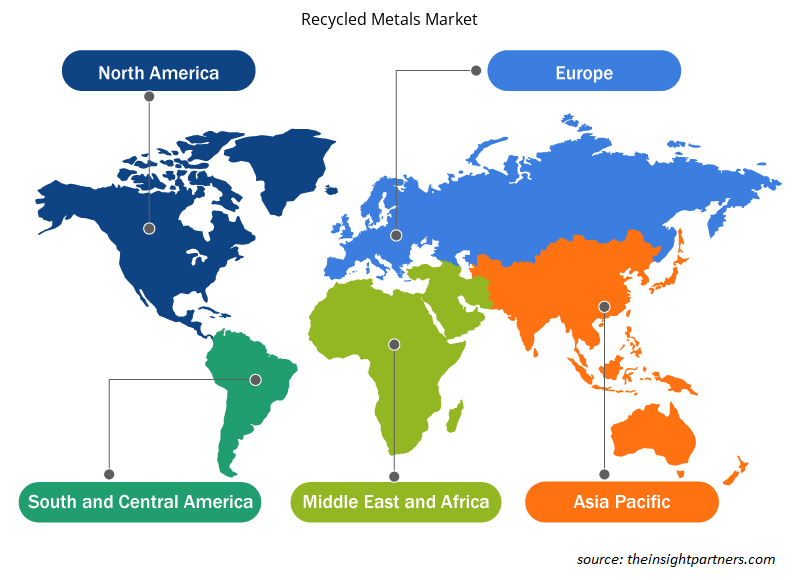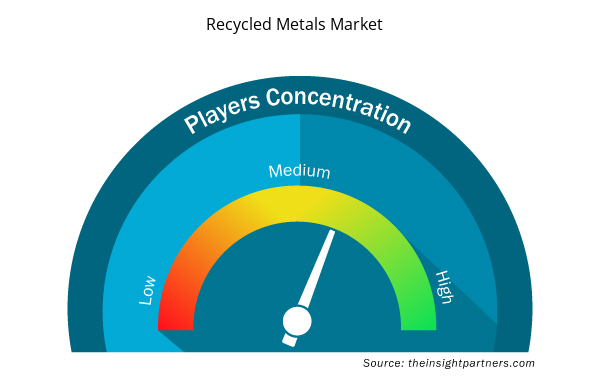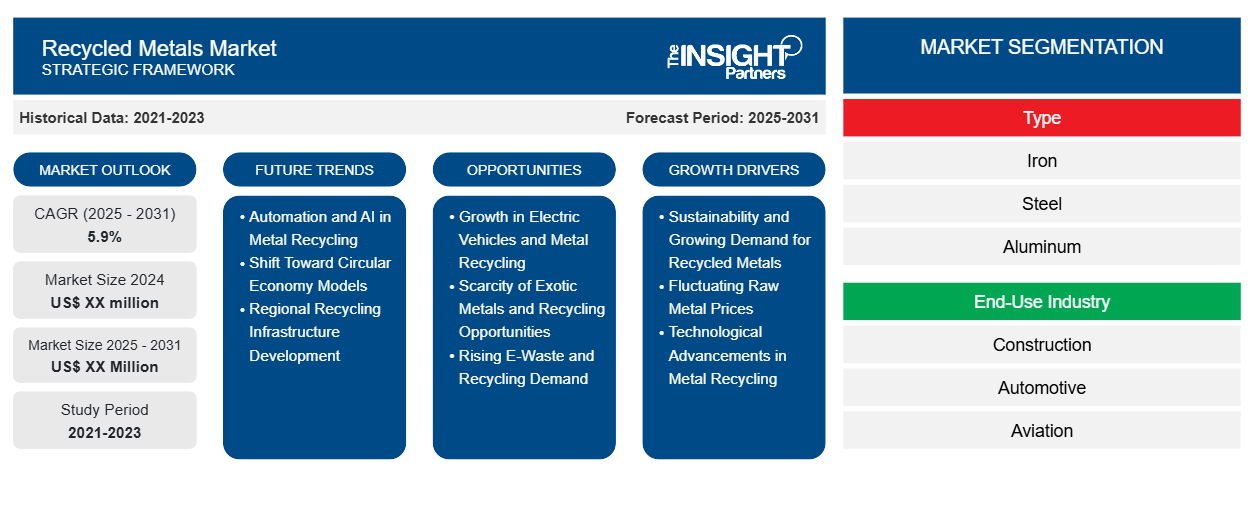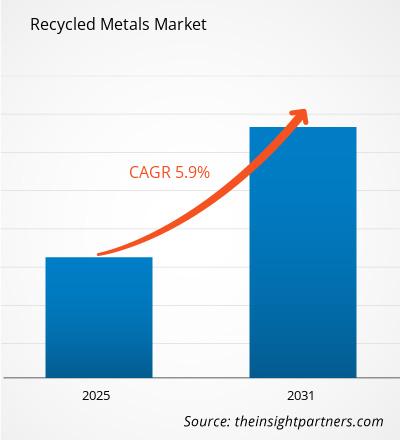Si prevede che il mercato dei metalli riciclati registrerà un CAGR del 5,9% dal 2023 al 2031, con una dimensione di mercato in espansione da XX milioni di dollari USA nel 2023 a XX milioni di dollari USA entro il 2031.
Il report è segmentato per tipo (ferro, acciaio, alluminio, rame, nichel, platino, piombo, stagno e altri). Il report è ulteriormente segmentato per settore di utilizzo finale (edilizia, automotive, aviazione, beni di consumo durevoli, macchinari industriali, imballaggi e altri). L'ambito del report copre cinque regioni: Nord America, Europa, Asia Pacifico, Medio Oriente e Africa e Sud e Centro America e paesi chiave in ciascuna regione. L'analisi globale è ulteriormente suddivisa a livello regionale e nei principali paesi. Il report offre il valore in USD per l'analisi e i segmenti di cui sopra.
Scopo del rapporto
Il report Recycled Metals Market di The Insight Partners mira a descrivere il panorama attuale e la crescita futura, i principali fattori trainanti, le sfide e le opportunità. Ciò fornirà spunti a vari stakeholder aziendali, come:
- Fornitori/produttori di tecnologia: per comprendere le dinamiche di mercato in evoluzione e conoscere le potenziali opportunità di crescita, consentendo loro di prendere decisioni strategiche informate.
- Investitori: condurre un'analisi completa delle tendenze in merito al tasso di crescita del mercato, alle proiezioni finanziarie del mercato e alle opportunità esistenti lungo la catena del valore.
- Enti di regolamentazione: regolamentano le politiche e le attività di controllo sul mercato allo scopo di ridurre al minimo gli abusi, preservare la fiducia degli investitori e sostenere l'integrità e la stabilità del mercato.
Segmentazione del mercato dei metalli riciclati
Tipo
- Ferro
- Acciaio
- Alluminio
- Rame
- Nichel
- Platino
- Guida
- Stagno
Settore di utilizzo finale
- Costruzione
- Automobilistico
- Aviazione
- Beni di consumo durevoli
- Macchinari industriali
- Confezione
Personalizza questo report in base alle tue esigenze
Riceverai la personalizzazione gratuita di qualsiasi report, comprese parti di questo report, o analisi a livello nazionale, pacchetto dati Excel, oltre a usufruire di grandi offerte e sconti per start-up e università
- Scopri le principali tendenze di mercato in questo rapporto.Questo campione GRATUITO includerà analisi di dati che spaziano dalle tendenze di mercato alle stime e alle previsioni.
Fattori trainanti della crescita del mercato dei metalli riciclati
- Sostenibilità e crescente domanda di metalli riciclati: con la diffusione della consapevolezza ambientale, la sostenibilità è sulla bocca di tutti nelle industrie odierne. Governi, aziende e consumatori stanno diventando sempre più rispettosi dell'ambiente, il che aumenta la domanda di metalli riciclati. Il riciclaggio metallurgico conserva le risorse naturali, risparmia energia e riduce gli effetti del degrado ambientale. Regolamentazioni come le tasse sul carbonio e gli standard di gestione dei rifiuti incoraggiano le aziende ad adottare modelli di economia circolare, spingendo la domanda di metalli riciclati come alternativa verde ai metalli vergini.
- Prezzi fluttuanti dei metalli grezzi: le fluttuazioni globali del prezzo dei metalli vergini (alluminio, rame e acciaio) spesso influenzano la domanda di metalli riciclati. Quando i metalli grezzi diventano troppo costosi da estrarre, riciclateli. La tendenza più recente per questo fenomeno è nei settori dell'automobile e dell'edilizia, dove la domanda di metalli rimane elevata e il riciclaggio dei metalli offre un vantaggio di prezzo con la sostenibilità come ulteriore vantaggio. Il riciclaggio fornirà stabilità alle aziende con prezzi dei metalli fluttuanti perché offre una catena di fornitura più economica.
- Progressi tecnologici nel riciclaggio dei metalli: i progressi tecnologici nella tecnologia del riciclaggio dei metalli rendono i processi più efficienti con prodotti di output di qualità superiore. Le tecniche migliorate di smistamento consentono un migliore utilizzo della separazione automatizzata e una fusione più efficace, garantendo una maggiore purezza e resa nei metalli da riciclare. Le innovazioni in questa tecnologia hanno reso il riciclaggio più conveniente, consentendo a più settori di utilizzare i metalli riciclati disponibili in applicazioni di fascia alta, tra cui l'elettronica e il settore automobilistico, che sono significativamente ad alta integrità dei materiali. Le più recenti tecnologie di riciclaggio rendono l'estrazione di metalli preziosi più economica, migliorando il mercato complessivo.
Tendenze future del mercato dei metalli riciclati
- Automazione e intelligenza artificiale nel riciclaggio dei metalli: le tecnologie di automazione e intelligenza artificiale vengono incorporate nel settore del riciclaggio dei metalli nel tentativo di semplificare la selezione, l'elaborazione e il trasporto dei rottami metallici. I sistemi di selezione automatizzati basati sull'intelligenza artificiale e sull'apprendimento automatico migliorano l'identificazione dei metalli con maggiore accuratezza, migliorando la qualità della produzione di materiali riciclati e riducendo i costi operativi. Le innovazioni apportate tramite questi progressi stanno rendendo il processo di riciclaggio più rapido e sicuro, un'attrattiva apprezzata sia dai riciclatori su larga scala che dalle piccole imprese.
- Passaggio a modelli di economia circolare: sempre più settori si stanno orientando verso il modello di economia circolare, in cui non solo riciclano rottami metallici, ma progettano anche prodotti più facili da riciclare. Ciò avviene in molti settori come l'elettronica, l'automotive e l'imballaggio, in cui i produttori stanno integrando metalli riciclabili nei loro progetti. Esistono programmi di ritiro adottati dalle aziende per raccogliere prodotti usati da riciclare. Questo passaggio a un'economia circolare ha raccolto i benefici del mercato dei metalli riciclati nell'aumento delle forniture di rottami metallici da riciclare.
- Sviluppo delle infrastrutture di riciclaggio regionali: un'importanza crescente nel mercato dei metalli riciclati è rappresentata dalle infrastrutture di riciclaggio regionali e dalle nazioni, in particolare quei paesi all'interno dell'Unione Europea e del Nord America, che stanno lavorando per costruire capacità di riciclaggio interne più significative per spostare la loro dipendenza dai rottami metallici importati. La tendenza regionale va anche di pari passo con la crescente importanza attribuita al contenimento dei costi di trasporto e alla riduzione dell'impronta di carbonio portata con sé quando si spediscono rottami metallici oltre i confini nazionali.
Opportunità di mercato dei metalli riciclati
- Crescita dei veicoli elettrici e riciclaggio dei metalli: la crescita dei veicoli elettrici è osservata a livello globale, aumentando così la domanda di alluminio, rame e litio. Questi metalli sono utilizzati nei veicoli elettrici, in particolare nelle batterie e nei motori e in molti componenti della carrozzeria progettati per ridurre il peso dei veicoli. Il loro riciclaggio può rappresentare un'opportunità per affrontare la crescente domanda in modo ecologico. C'è la necessità di aumentare la disponibilità di metalli riciclati per integrare le scorte estratte e di conseguenza alleviare gli effetti dell'estrazione di tali metalli.
- Scarsità di metalli esotici e opportunità di riciclaggio: l'aumento del consumo di metalli rari ed esotici come litio, cobalto ed elementi delle terre rare nei prodotti elettronici e nelle apparecchiature per l'energia rinnovabile fornirà un nuovo mercato per il business del riciclaggio. Attualmente non sono disponibili processi di riciclaggio per questi metalli, ma con il miglioramento della tecnologia, nuove tecnologie potrebbero diventare praticabili per riciclare economicamente questi materiali da componenti elettronici a fine vita, batterie esaurite e infrastrutture per l'energia rinnovabile. Ciò creerebbe una nuova fonte di reddito per il mercato dei metalli riciclati e contribuirebbe al passaggio del mondo verso un'energia più pulita.
- Aumento della domanda di rifiuti elettronici e riciclaggio: poiché il volume di rifiuti elettronici è in aumento a livello globale, un notevole margine per i metalli riciclati risiede nell'elettronica di consumo scartata. I metalli presenti nei rifiuti elettronici includono oro, argento, rame e palladio. Le normative, insieme a una maggiore consapevolezza tra i consumatori, costringerebbero a migliorare i metodi di riciclaggio dei rifiuti elettronici, il che fornirebbe al mondo la fonte di metalli tanto necessaria oltre a prendersi cura dei problemi ambientali derivanti dalla generazione di rifiuti elettronici. Man mano che i paesi si muovono verso una legislazione più forte sul riciclaggio dei rifiuti elettronici, più aziende specializzate in questa nicchia possono conquistare una quota di mercato maggiore.
Approfondimenti regionali sul mercato dei metalli riciclati
Le tendenze regionali e i fattori che influenzano il mercato dei metalli riciclati durante il periodo di previsione sono stati ampiamente spiegati dagli analisti di Insight Partners. Questa sezione discute anche i segmenti e la geografia del mercato dei metalli riciclati in Nord America, Europa, Asia Pacifico, Medio Oriente e Africa e America meridionale e centrale.

- Ottieni i dati specifici regionali per il mercato dei metalli riciclati
Ambito del rapporto sul mercato dei metalli riciclati
| Attributo del report | Dettagli |
|---|---|
| Dimensioni del mercato nel 2023 | XX milioni di dollari USA |
| Dimensioni del mercato entro il 2031 | XX milioni di dollari USA |
| CAGR globale (2023-2031) | 5,9% |
| Dati storici | 2021-2022 |
| Periodo di previsione | 2024-2031 |
| Segmenti coperti | Per tipo
|
| Regioni e Paesi coperti | America del Nord
|
| Leader di mercato e profili aziendali chiave |
|
Densità degli attori del mercato dei metalli riciclati: comprendere il suo impatto sulle dinamiche aziendali
Il mercato dei metalli riciclati sta crescendo rapidamente, spinto dalla crescente domanda degli utenti finali dovuta a fattori quali l'evoluzione delle preferenze dei consumatori, i progressi tecnologici e una maggiore consapevolezza dei benefici del prodotto. Con l'aumento della domanda, le aziende stanno ampliando le loro offerte, innovando per soddisfare le esigenze dei consumatori e capitalizzando sulle tendenze emergenti, il che alimenta ulteriormente la crescita del mercato.
La densità degli operatori di mercato si riferisce alla distribuzione di aziende o società che operano in un particolare mercato o settore. Indica quanti concorrenti (operatori di mercato) sono presenti in un dato spazio di mercato in relazione alle sue dimensioni o al valore di mercato totale.
Le principali aziende che operano nel mercato dei metalli riciclati sono:
- Aaron Metalli
- Riciclaggio di metalli del secolo limitato
- Riciclaggio europeo dei metalli limitato
- Gruppo Kuusakoski Oy
- Società Nucor
Disclaimer : le aziende elencate sopra non sono classificate secondo un ordine particolare.

- Ottieni una panoramica dei principali attori del mercato dei metalli riciclati
Punti chiave di vendita
- Copertura completa: il rapporto esamina in modo completo i prodotti, i servizi, le tipologie e gli utenti finali del mercato dei metalli riciclati, fornendo una panoramica olistica.
- Analisi degli esperti: il rapporto è compilato sulla base della conoscenza approfondita di esperti e analisti del settore.
- Informazioni aggiornate: il rapporto garantisce la pertinenza aziendale grazie alla copertura di informazioni recenti e tendenze nei dati.
- Opzioni di personalizzazione: questo report può essere personalizzato per soddisfare le esigenze specifiche del cliente e adattarsi in modo appropriato alle strategie aziendali.
Il rapporto di ricerca sul mercato dei metalli riciclati può quindi aiutare a guidare il percorso di decodificazione e comprensione dello scenario del settore e delle prospettive di crescita. Sebbene possano esserci alcune preoccupazioni valide, i vantaggi complessivi di questo rapporto tendono a superare gli svantaggi.
- Analisi storica (2 anni), anno base, previsione (7 anni) con CAGR
- Analisi PEST e SWOT
- Valore/volume delle dimensioni del mercato - Globale, regionale, nazionale
- Industria e panorama competitivo
- Set di dati Excel


- Volumetric Video Market
- Smart Parking Market
- Artificial Intelligence in Healthcare Diagnosis Market
- Advanced Planning and Scheduling Software Market
- MEMS Foundry Market
- Influenza Vaccines Market
- Frozen Potato Market
- Electronic Health Record Market
- Airport Runway FOD Detection Systems Market
- Transdermal Drug Delivery System Market

Report Coverage
Revenue forecast, Company Analysis, Industry landscape, Growth factors, and Trends

Segment Covered
This text is related
to segments covered.

Regional Scope
North America, Europe, Asia Pacific, Middle East & Africa, South & Central America

Country Scope
This text is related
to country scope.
Domande frequenti
Integration of artificial intelligence and automation is expected to be the key market trend.
The report can be delivered in PDF/Word format, we can also share excel data sheet based on request.
On the basis of geography, the recycled metals market is classified into North America, Europe, Asia Pacific, Middle East and Africa, and South and Central America
Schnitzer Steel Industries Inc, ArcelorMittal SA, European Metal Recycling Ltd, Norsk Hydro ASA, Hindalco Industries Ltd, Aurubis AG, Nucor Corp, Commercial Metals Co, Sims Ltd, and DOWA HOLDINGS CO LTD
The major factors driving the recycled metals market are:
1. Increasing Demand for Sustainable Practices.
2. Rising Scrap Metal Prices.
The Recycled Metals Market is estimated to witness a CAGR of 5.9% from 2023 to 2031
Trends and growth analysis reports related to Chemicals and Materials : READ MORE..
The List of Companies
1. Aaron Metals
2. Century Metal Recycling Limited
3. European Metal Recycling Limited
4. Kuusakoski Group Oy
5. Nucor Corporation
6. OmniSource Corp. (Steel Dynamics Inc. )
7. SA Recycling LLC
8. Schnitzer Steel Industries, Inc.
9. Sims Metal Management Ltd
10. Umicore N. V.
The Insight Partners performs research in 4 major stages: Data Collection & Secondary Research, Primary Research, Data Analysis and Data Triangulation & Final Review.
- Data Collection and Secondary Research:
As a market research and consulting firm operating from a decade, we have published and advised several client across the globe. First step for any study will start with an assessment of currently available data and insights from existing reports. Further, historical and current market information is collected from Investor Presentations, Annual Reports, SEC Filings, etc., and other information related to company’s performance and market positioning are gathered from Paid Databases (Factiva, Hoovers, and Reuters) and various other publications available in public domain.
Several associations trade associates, technical forums, institutes, societies and organization are accessed to gain technical as well as market related insights through their publications such as research papers, blogs and press releases related to the studies are referred to get cues about the market. Further, white papers, journals, magazines, and other news articles published in last 3 years are scrutinized and analyzed to understand the current market trends.
- Primary Research:
The primarily interview analysis comprise of data obtained from industry participants interview and answers to survey questions gathered by in-house primary team.
For primary research, interviews are conducted with industry experts/CEOs/Marketing Managers/VPs/Subject Matter Experts from both demand and supply side to get a 360-degree view of the market. The primary team conducts several interviews based on the complexity of the markets to understand the various market trends and dynamics which makes research more credible and precise.
A typical research interview fulfils the following functions:
- Provides first-hand information on the market size, market trends, growth trends, competitive landscape, and outlook
- Validates and strengthens in-house secondary research findings
- Develops the analysis team’s expertise and market understanding
Primary research involves email interactions and telephone interviews for each market, category, segment, and sub-segment across geographies. The participants who typically take part in such a process include, but are not limited to:
- Industry participants: VPs, business development managers, market intelligence managers and national sales managers
- Outside experts: Valuation experts, research analysts and key opinion leaders specializing in the electronics and semiconductor industry.
Below is the breakup of our primary respondents by company, designation, and region:

Once we receive the confirmation from primary research sources or primary respondents, we finalize the base year market estimation and forecast the data as per the macroeconomic and microeconomic factors assessed during data collection.
- Data Analysis:
Once data is validated through both secondary as well as primary respondents, we finalize the market estimations by hypothesis formulation and factor analysis at regional and country level.
- Macro-Economic Factor Analysis:
We analyse macroeconomic indicators such the gross domestic product (GDP), increase in the demand for goods and services across industries, technological advancement, regional economic growth, governmental policies, the influence of COVID-19, PEST analysis, and other aspects. This analysis aids in setting benchmarks for various nations/regions and approximating market splits. Additionally, the general trend of the aforementioned components aid in determining the market's development possibilities.
- Country Level Data:
Various factors that are especially aligned to the country are taken into account to determine the market size for a certain area and country, including the presence of vendors, such as headquarters and offices, the country's GDP, demand patterns, and industry growth. To comprehend the market dynamics for the nation, a number of growth variables, inhibitors, application areas, and current market trends are researched. The aforementioned elements aid in determining the country's overall market's growth potential.
- Company Profile:
The “Table of Contents” is formulated by listing and analyzing more than 25 - 30 companies operating in the market ecosystem across geographies. However, we profile only 10 companies as a standard practice in our syndicate reports. These 10 companies comprise leading, emerging, and regional players. Nonetheless, our analysis is not restricted to the 10 listed companies, we also analyze other companies present in the market to develop a holistic view and understand the prevailing trends. The “Company Profiles” section in the report covers key facts, business description, products & services, financial information, SWOT analysis, and key developments. The financial information presented is extracted from the annual reports and official documents of the publicly listed companies. Upon collecting the information for the sections of respective companies, we verify them via various primary sources and then compile the data in respective company profiles. The company level information helps us in deriving the base number as well as in forecasting the market size.
- Developing Base Number:
Aggregation of sales statistics (2020-2022) and macro-economic factor, and other secondary and primary research insights are utilized to arrive at base number and related market shares for 2022. The data gaps are identified in this step and relevant market data is analyzed, collected from paid primary interviews or databases. On finalizing the base year market size, forecasts are developed on the basis of macro-economic, industry and market growth factors and company level analysis.
- Data Triangulation and Final Review:
The market findings and base year market size calculations are validated from supply as well as demand side. Demand side validations are based on macro-economic factor analysis and benchmarks for respective regions and countries. In case of supply side validations, revenues of major companies are estimated (in case not available) based on industry benchmark, approximate number of employees, product portfolio, and primary interviews revenues are gathered. Further revenue from target product/service segment is assessed to avoid overshooting of market statistics. In case of heavy deviations between supply and demand side values, all thes steps are repeated to achieve synchronization.
We follow an iterative model, wherein we share our research findings with Subject Matter Experts (SME’s) and Key Opinion Leaders (KOLs) until consensus view of the market is not formulated – this model negates any drastic deviation in the opinions of experts. Only validated and universally acceptable research findings are quoted in our reports.
We have important check points that we use to validate our research findings – which we call – data triangulation, where we validate the information, we generate from secondary sources with primary interviews and then we re-validate with our internal data bases and Subject matter experts. This comprehensive model enables us to deliver high quality, reliable data in shortest possible time.


 Ottieni un campione gratuito per questo repot
Ottieni un campione gratuito per questo repot